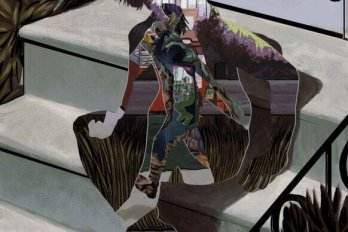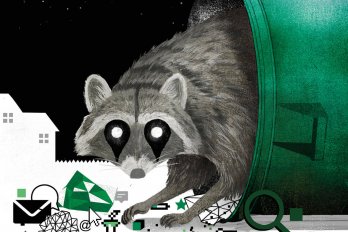“What we’re looking for is between a batter and a dough,” Andrew George tells a small group of students on a cloudy spring morning. George, a fifty-two-year-old Wet’suwet’en chef, is teaching a culinary course on the Tsleil-Waututh reserve. Measuring cups and spoons, whisks and rolling pins, and a large yellow sack of flour are laid out on the stainless-steel countertops. George is a lean five feet eight, and his forearms are peppered with faint scars—the results of his thirty-plus years working as a chef. He demonstrates stirring the mixture, the floury paste sticking to his fingers. Today, he’s teaching his class to make bannock, a dish he could make in his sleep.
There are many recipes for bannock, but the ingredients stay more or less the same: flour, baking powder, sugar, salt, milk, and lard. No matter the cooking method—deep-fried, pan-fried, baked, or cooked over a campfire—a good bannock is chewy and dense and moist. Many Native cooks have more than one recipe for the quick bread, which can be prepared in both savoury and sweet variations, in their culinary repertoires. Dolly Watts, a Gitxsan chef, includes eight bannock dishes in the cookbook she co-authored with Annie Watts, Where People Feast. She recommends that her readers bake bannock crackers when serving pemmican canapés. George’s 1997 cookbook, Feast!, details six types of bannock, which he suggests pairing with boiled porcupine, moose-rib soup, or Taas Guz (a cold huckleberry soup). “It’s one of our basic food groups,” he writes. “You won’t find a Native community in Canada where bannock is not made in one form or another.”
Though it’s typically considered a “traditional” Aboriginal food, and sometimes even the Aboriginal food, bannock was first made elsewhere. The story goes something like this: originally a Scottish bread, brought here in the bellies of ships carrying fur traders and early settlers during the late eighteenth century, bannock—bannach in Scots Gaelic—was adopted and adapted by Indigenous nations across the country. The story is true, but it’s also deceptively simple. Yes, sacks of flour entered the trade routes and mingled with oolichan grease and dried salmon. And bannock was feasted on, with whale meat and broiled seal and the steamed roots of springbank clover, in the longhouses along the northwest coast. But to talk about food is to talk about land, and bannock occupies a conflicted territory.
KC Adams is a Winnipeg-based Oji-Cree artist whose work explores the relationship between food and colonization. She eats a “hunter-gatherer” diet and has sworn off bannock. She calls it “European food.” Her kitchen is stocked with bison, elk, squash, turkey eggs, berries, and wild rice—foods that are indigenous to North America.
Just as important as what Adams eats is what she does not eat. No sugar, lard, milk, salt, or flour—the main ingredients for bannock. Or, as Adams calls them in her artistic practice, “the five gifts of the white man.” For an installation project, The Gift That Keeps on Giving, Adams pinch-potted thirty conical vessels in the style of early Prairie pottery. She then poured milk and scooped lard, sugar, salt, and flour into the vessels. “The clay pots are a metaphor for our bodies,” she explains. Adams left the pots unfired so the clay would remain porous and permeable, susceptible to the influences of the ingredients. Much as food affects the body, the “five gifts” altered the pots. “The salt changed the composition, the milk made the clay disintegrate,” she says.
The Indian Act of 1876 and related policies of the Canadian government have historically carved off tiny fragments of Indigenous territories, often the least fertile and desirable plots, to “give” to Aboriginal peoples as reserves. Settlers chose the good cuts of land, unpacked their cattle and pigs, and set up their fences. “Many of the spaces that were cultivated and created by Indigenous communities for food crops were the first places taken over by settlers,” says Coll Thrush, an associate professor of history at the University of British Columbia. Settlers plowed over gardens of rice root and silverweed. Access to Indigenous hunting and fishing sites was blocked. Grocery foods and government-issued rations of bacon, salt, sugar, flour, baking soda, and lard displaced foods from the land. And the “five gifts of the white man” became a part of daily life.
Historical dislocation—resulting in limited access to traditional foods—contributes to the high rates of diabetes in contemporary Aboriginal communities. Store-bought refined carbohydrates (such as white flour and sugar) top the list of foods tied to the disease. According to the most recent census, nearly 2.4 million Canadians (7 percent) live with diabetes. The prevalence among the non-Aboriginal population is 5 percent. Within the First Nations community, though, the rates are much higher: 17 percent among those living on-reserve and 10 percent for those living off-reserve.
Adams, whose mother suffers from diabetes, has a deeply personal connection to the disproportionate odds of developing the disease as an Aboriginal person. Diabetes and the health impacts of “the five gifts of the white man” are a thematic concern in her work, but also a reality she confronts when choosing her meals.
While Adams plans to sustain her “hunter-gatherer” diet indefinitely, it’s expensive. Food security, the ability to access affordable and healthy food, is a significant struggle for many Indigenous communities. A 2014 report by PROOF, a research team based at the University of Toronto that focuses on food insecurity, indicates that 26 percent of the Aboriginal population experiences food insecurity, a rate that is more than double that of Canada’s Caucasian and Asian populations. According to a recent Harvard study, which included Canadian food prices, healthy ingredients are more expensive than unhealthy ones. In Canada, the national average cost for two and a half kilograms of white flour is $5.13, whereas a 213-gram can of sockeye salmon is $4.57. Nunavut, on the other hand, has the highest rate of food insecurity in the country (37 percent), more than four times the national average. On Baffin Island, a two-and-a-half kilogram bag of white flour costs $13.85, and a 213-gram can of sockeye salmon is $6.62. The ability to buy a can of salmon is one thing, but having the land base to access traditional foods is another matter.
Althea Guiboche, who is Métis, Ojibway, and Cree, is the founder of Got Bannock?, a non-profit that delivers fresh bannock and stew to the homeless in Winnipeg. For the homeless people she serves, a disproportionate number of whom are Aboriginal, bannock is comfort food. Even if the food does come from a legacy of colonization, “it takes them back to that home base that they used to have,” says Guiboche.
“When we got pushed onto reserves and were being fed lard and sugar and salt and flour, it was a survival food,” says Martin Reinhardt, who is Anishinaabe Ojibway and an associate professor of Native American Studies at Northern Michigan University. Like Adams, Reinhardt considers eating a pre-colonial diet a form of political resistance. A few years ago, Reinhardt was serving up fry bread, a type of bannock, at a fundraising event, when he asked himself, “Would my ancestors even recognize this as food?” His question led him to develop a year-long study called the Decolonizing Diet Project, in which twenty-five participants, including Reinhardt, ate a diet of foods indigenous to the Great Lakes region. For Reinhardt, like Adams, decolonizing means not eating bannock. “People are calling it Indian soul food,” he says. “Fry bread helped us to survive in a period of colonization—why would we celebrate that and internalize that?”
Since Adams started her “hunter-gatherer” diet, she’s primarily been dining at home. Recently, she reintroduced salt after discovering the ingredient’s pre-contact ties to communities on the historic Aboriginal trade routes in present-day Saskatchewan. Even so, it’s still incredibly difficult for her to dine out, because, across this vast country, there are very few restaurants serving explicitly Indigenous foods. Yet the menus of some of the hottest locavore restaurants—those serving “foraged” and “wild” foods—feature bison, duck, halibut, kelp, and juniper. These are Native foods, but they are seldom described as such when they appear in trendy locavore dishes.
I ask Adams whether she thinks that some of the “local” foods currently in vogue should really be called “Indigenous.” “It would certainly make sense,” she says. But, she adds, given the long history of systemic racism against the Indigenous population, “I don’t know how well it would go over—that’s the thing.” Reinhardt sees it a bit differently. “It’s appropriation,” he says. Restaurants that serve up Indigenous ingredients but call them “local” are appropriating those foods, a process with a long legacy in the colonial project.
The erasure of Indigenous cuisine from “eating local” mirrors the ways in which indigeneity has historically been written out of the landscape. Europeans in the eighteenth and nineteenth centuries subscribed to the notion of terra nullius, or “empty land,” a view that led them to act as though Indigenous territories were “empty” and ripe for the taking. Today, Indigenous foods are largely invisible, even as dishes described in terms of their connection to the land grow in popularity. Native foods are there, served up on plates, we’re just giving them names more palatable to non-Aboriginal diners, who would perhaps feel uncomfortable being so directly implicated in the colonial project. And maybe that’s why bannock, a food made of ingredients with no pre-colonial ties to Aboriginal territories, is often the only “Indigenous” dish that settlers can name.
“It’s important to not get caught in the trap. You know, drawing the lines of ‘this is Indigenous’ and ‘this is not,’” says Anishinaabe chef and artist Lisa Myers. “There is this pre-/post-contact evaluation of things. There’s not a line of ‘everything changed as soon as contact.’ There was an exchange, a constant exchange.”
In her work, Myers has incorporated performances involving wild rice and has used blueberry pigment as a dye and ink. Five years ago, she curated the exhibit Best Before, which explored how family traditions grow around recipes, including ones with ingredients tied to colonization. Adams’s The Gift That Keeps on Giving was part of Myers’s exhibit, which appeared in Toronto at OCAD University. Like Adams’s clay vessels, culture is porous, explains Myers. (She was there when the milk finally disintegrated Adams’s pinch pots.) Cuisines, like cultures, shift. All culinary traditions have been forged and pushed and innovated. And bannock is no exception. “White flour, baking powder, and water becomes this thing that is so valued and has this whole mythology around it—bannock,” she says. “How can we not acknowledge that as being valid?”
Around seven o’clock on a hot June night, after a family dinner at Andrew George’s home on the outskirts of Vancouver, we are clearing the dishes and talking about Aboriginal cuisine. The sun is still bright. The white blinds have been drawn to keep the room cool, and every fan in the house has been plugged in near the kitchen table. On the counter, next to the stove, stand a couple of bags packed with leftover bannock from our meal.
Bannock matters to George. It’s about family, tradition. It was one of the first recipes he learned. Growing up in Wet’sutwet’en territory, a place of rivers and mountains and salmon and bears in northwestern British Columbia, George remembers standing on a stool next to his family’s wood stove and watching his mother make bannock. “And then when we’d go visit my grandma down the road, I’d bake the bannock there.”
Bannock is certainly part of the story of Aboriginal cuisine, and it has a place at the table. But it’s not the main dish.
This appeared in the June 2016 issue.





